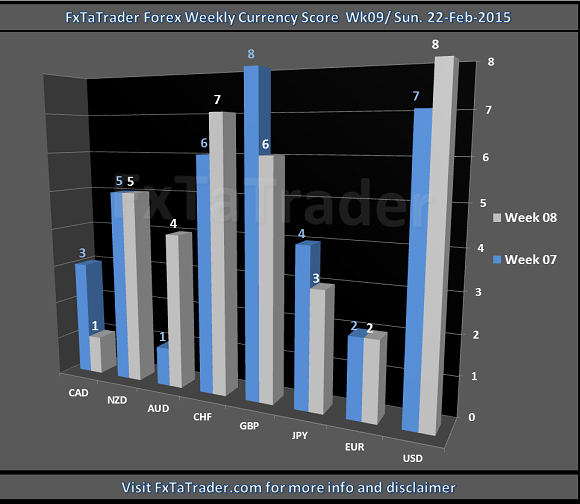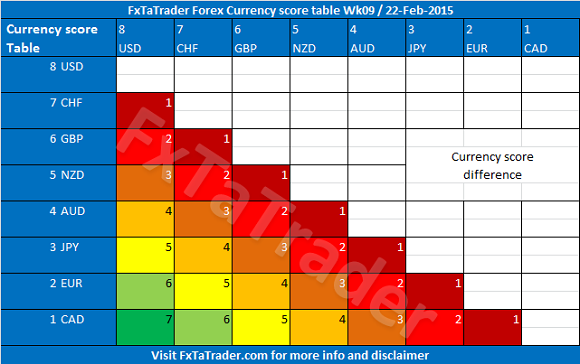This article has been improved and brought to a higher level by the modifications made. It is recommended to read the page Currency score explained and Models in practice for a better understanding of the articles and the new changes. This article will provide my analysis on the 8 major currencies based on the technical analysis charts using the MACD and Ichimoku indicator on 4 time frames, the monthly, weekly, daily and 4 hours. The result of the technical analysis are the 2 screenshots in this article showing the Currency Score and the Currency Score Difference.
___________________________________________
Last 3 months currency
classification
The last 3 months currency
classification from a longer term
perspective
are provided for reference
purposes. See for more information the article: Weekly Currency Score Wk03 where
the charts are available. The currencies are
classified for the coming weeks as follows:
- Strong: CHF / USD / NZD
- Average: GBP /CAD
- Weak: EUR / JPY / AUD
___________________________________________
Currency Score
- Most of the currencies are at the right level and some differ with just 1 point. However the CAD differs with 3 points being at a score of 1 while it should have at least a score of 4 being an average currency.
- There is a pullback at the moment for the AUD and the CAD.
- The pairs that we will look at are all most
probably trending except for the short AUD and long CAD positions which are most probably ranging.

___________________________________________
Currency
Score difference
- USD/CAD with the EUR/NZD
- GBP/CAD with the NZD/CAD
- EUR/USD with the GBP/JPY
- USD/JPY with the GBP/CAD

___________________________________________
The
technical analysis is the most important to consider before taking
positions. The Weekly Chart is being analyzed. I prefer the Bollinger
Band for defining where a pair is in the chart. Once a pair is outside
a Bollinger Band it is in a strong trend which can cause a strong
pullback. Although it may be for other analysts a good opportunity I
avoid taking positions because of the possible unexpected strong
pullback. Positions are only opened inside the Bollinger Band and this
may be at the start of a possible trend or on a good pullback in an
existing trend.
- The USD/CAD is clearly in a trend and nicely within the Bollinger Band.
- The EUR/NZD looks like it is picking up the downtrend again and is clearly within the Bollinger Band.
- The GBP/CAD is clearly in a trend but outside the Bollinger Band. However with the new value of the Bollinger Band next week the price may be within again.
- The NZD/CAD is clearly in a trend but outside the Bollinger Band. However with the new value of the Bollinger Band next week the price may be within again.
- The EUR/USD is clearly in a trend and nicely within the Bollinger Band.
- The GBP/JPY looks like picking up the uptrend and is clearly within the Bollinger Band.
- The USD/JPY looks like picking up the uptrend and is clearly within the Bollinger Band.
When trading according to the FxTaTrader Strategy some rules are in place. For more information see the page on my blog FxTaTrader Strategy. Depending on the opportunities that may come up the decision to trade a currency may become more obvious at that moment.
___________________________________________
DISCLAIMER: The articles are my personal opinion, not recommendations, FX trading is risky and not suitable for everyone.The content is for educational purposes only and is aimed solely for the use by ‘experienced’ traders in the FOREX market as the contents are intended to be understood by professional users who are fully aware of the inherent risks in forex trading. The content is for 'Forex Trading Journal' purpose only. Nothing should be construed as recommendation to purchase any financial instruments. The choice and risk is always yours. Thank you.


